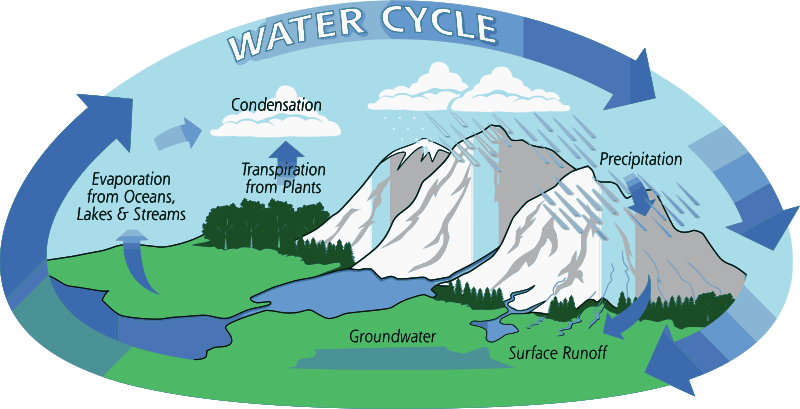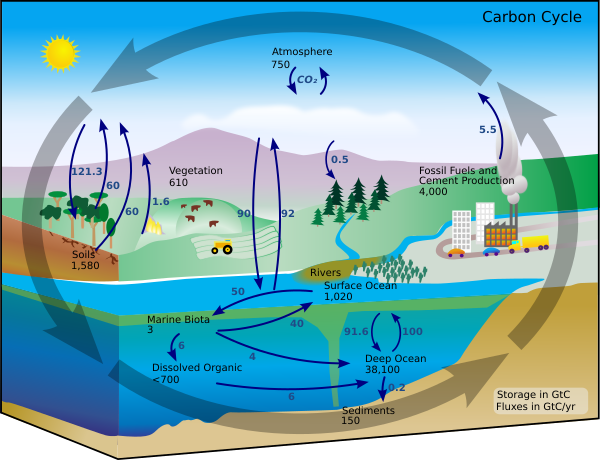AQA Specification focus:
‘Key role of carbon and water stores and cycles in supporting life and climate.’
Introduction
Water and carbon cycles are essential for sustaining ecosystems and regulating Earth’s climate, influencing life processes and maintaining planetary stability over time.
The Importance of Biogeochemical Cycles
Biogeochemical cycles describe how key elements like carbon and water move through the Earth's systems. These cycles interact with the atmosphere, biosphere, lithosphere, and hydrosphere to regulate life-supporting processes.
The carbon cycle and water cycle are both closed systems on a global scale, meaning matter does not leave the system, but energy can enter and leave (e.g., via solar radiation). On smaller scales, such as drainage basins or forest ecosystems, they operate as open systems, where matter and energy can be exchanged with surrounding systems.
Understanding their functioning is vital for explaining how Earth's climate is moderated and how living organisms survive and evolve.
Water Cycle: Supporting Life and Climate
Water as a Life Support System
Water is fundamental for all known life. Its availability and movement influence biological productivity, climate systems, and physical landscapes.
Water Cycle: The continuous movement of water between the atmosphere, hydrosphere, lithosphere, and biosphere through processes like evaporation, condensation, and precipitation.
Key roles of the water cycle in supporting life:
Hydration and growth of plants and animals.
Regulating temperature through processes like evaporation and transpiration, which help cool the Earth’s surface.
Enabling photosynthesis, where water is a necessary reactant.
Providing a medium for nutrient transport in biological systems.
Water Stores and Transfers
Major water stores include:
Atmosphere (water vapour)
Cryosphere (glaciers, ice caps)
Hydrosphere (oceans, rivers, lakes)
Lithosphere (groundwater, soil moisture)
Important transfers in the cycle:
Evaporation: Conversion of water from liquid to vapour.
Condensation: Vapour turns back into liquid, forming clouds.
Precipitation: Rain, snow, or other forms of water falling to the surface.
Infiltration and percolation: Water movement through soil and rock.
Runoff: Water flowing over land into bodies of water.
Transpiration: Water released from plant leaves.
These transfers help regulate climate by redistributing heat energy and controlling moisture availability.

This public-domain diagram shows the global water cycle’s main stores and flows, including evaporation, condensation, precipitation, infiltration, runoff, and transpiration. It also depicts ocean–atmosphere exchanges; minor human-land-surface details (e.g. urban runoff) appear but are not required by the syllabus. Source
Carbon Cycle: Regulating Climate and Enabling Life
Carbon’s Role in Life Processes
Carbon is the backbone of all organic molecules. It cycles through the Earth's spheres via biological, chemical, and physical processes, supporting both life and climate regulation.
Carbon Cycle: The continuous movement of carbon among the Earth’s atmosphere, biosphere, oceans, and lithosphere through processes such as photosynthesis, respiration, and combustion.
Carbon's biological roles:
Photosynthesis captures carbon dioxide (CO₂) to produce glucose.
Respiration returns CO₂ to the atmosphere from organisms.
Decomposition of organic matter releases stored carbon into soils and air.
Carbon Stores and Transfers
Key carbon stores include:
Atmosphere (CO₂ and methane)
Biosphere (living organisms and decaying matter)
Lithosphere (fossil fuels, rocks, sediments)
Hydrosphere (dissolved carbon in oceans)
Essential flows/transfers:
Photosynthesis: Removes atmospheric CO₂.
Respiration and combustion: Return CO₂ to the air.
Decomposition: Releases carbon from dead organisms.
Sequestration: Long-term storage of carbon, especially in oceans and soils.
Carbon stores directly influence Earth’s radiation balance, with greenhouse-gas fluxes modulating global climate.

Diagram of the global carbon cycle showing carbon storage (black values) and annual exchanges (blue arrows) among atmosphere, hydrosphere, and geosphere in gigatons (Gt C). The numeric flux data (e.g. fossil fuel emissions) exceed syllabus requirements but illustrate the scale of human impact. Source
Interdependence of the Cycles
Feedback Mechanisms
The carbon and water cycles interact in complex feedback loops. For example:
Warmer temperatures increase evaporation and plant respiration, releasing more water vapour and CO₂—both greenhouse gases—into the atmosphere.
Melting permafrost (cryospheric change) releases methane and CO₂, enhancing global warming and further altering both cycles.
Increased cloud formation from higher evaporation may reflect solar radiation, cooling the planet—a negative feedback.
Dynamic Equilibrium
Both cycles strive for dynamic equilibrium, where inflows and outflows remain balanced over time. Disruption—natural or anthropogenic—can shift the system.
Dynamic Equilibrium: A state of balance in a system where inputs and outputs are equal over time, despite small fluctuations.
When equilibrium is disrupted (e.g., via deforestation, fossil fuel use), it affects climate stability and biological resilience.
Supporting Climate and Ecosystems
Ecosystem Productivity
Water and carbon are essential for net primary productivity (NPP) in ecosystems.
Healthy cycles enable ecosystems to sequester carbon, regulate hydrological flows, and support biodiversity.
Climate Regulation
The two cycles help moderate temperature, humidity, and atmospheric composition. For example:
Forests act as both carbon sinks and transpiration hubs, influencing both CO₂ levels and rainfall.
Oceans absorb CO₂ and distribute heat via currents, linking water and carbon processes.
Resilience and Sustainability
Understanding these cycles enables strategies for climate change mitigation, such as:
Afforestation to enhance carbon sinks.
Sustainable water management to protect hydrological stability.
Together, these cycles maintain Earth’s habitability, drive evolutionary processes, and shape the physical environment through their influence on climate and resource availability.
FAQ
When dynamic equilibrium is disrupted, ecosystems may become less resilient. For example, excess CO₂ disrupts atmospheric carbon levels, intensifying climate change and altering temperature and rainfall patterns.
In the water cycle, prolonged imbalances—such as drought or flooding—can reduce biodiversity, hinder plant growth, and stress freshwater systems.
Recovery from such disturbances often depends on the scale and duration of the imbalance and the adaptive capacity of the ecosystem.
Vegetation acts as a key interface between the two cycles:
Through photosynthesis, plants absorb CO₂, sequestering carbon in biomass.
Via transpiration, vegetation releases water vapour, affecting local humidity and precipitation.
Forests contribute to carbon storage and water recycling, especially in tropical rainforests, where these processes are highly efficient.
Deforestation breaks these links, reducing carbon uptake and disrupting hydrological feedback loops.
Oceans are major global stores:
In the water cycle, they are the largest source of evaporation and help regulate global temperature via heat distribution.
In the carbon cycle, oceans absorb CO₂ from the atmosphere and store it as dissolved inorganic carbon.
Marine organisms also play a role by using carbon to build shells and skeletons, which sink and store carbon long term.
Positive feedback enhances change:
Melting permafrost releases methane, increasing warming.
Reduced snow cover lowers albedo, increasing heat absorption and further melting.
Negative feedback counteracts change:
Increased CO₂ may promote plant growth, which increases carbon uptake.
More evaporation may lead to greater cloud cover, which can reflect solar radiation and cool the surface.
Rising global temperatures intensify the interaction between cycles:
Higher temperatures increase evaporation and plant respiration, accelerating both cycles.
Drought reduces vegetation, weakening carbon sequestration and amplifying atmospheric CO₂.
Wildfires, more frequent with warming, release stored carbon and reduce vegetative cover, affecting transpiration and rainfall.
This creates feedback loops that can destabilise climate and reduce ecosystem services.
Practice Questions
Identify three stores involved in the global carbon cycle. (3 marks)
Award 1 mark for each correct store, up to a maximum of 3 marks.
Atmosphere ✔
Biosphere ✔
Lithosphere ✔
Hydrosphere ✔
Cryosphere ✔
Maximum: 3 marks
Explain how the water and carbon cycles support life on Earth and influence global climate systems. (6 marks)
Level 1 (1–2 marks):
Basic understanding with limited detail. Simple statements with little or no linkage to climate or life support.
Example: “Water helps plants grow. Carbon is used in photosynthesis.”
Level 2 (3–4 marks):
Developed response with some explanation of how the cycles support life and/or climate. May focus more on one cycle. Some accurate terminology.
Example: “The water cycle supports life by providing moisture for photosynthesis and cooling the environment through evaporation. The carbon cycle removes CO₂ through photosynthesis and stores it in plants.”
Level 3 (5–6 marks):
Detailed and well-developed explanation. Clear understanding of both cycles, using accurate terminology and linking both to climate regulation and life processes.
Example: “The water cycle supports life through hydration, enabling photosynthesis and regulating temperature via evaporation and transpiration. The carbon cycle provides carbon for plant growth through photosynthesis and regulates global climate by storing and cycling greenhouse gases like CO₂.”
Maximum: 6 marks

